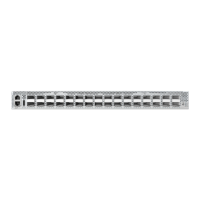C
HAPTER
25
| SNMP Commands
– 640 –
◆ Before you configure a remote user, use the snmp-server engine-id
command to specify the engine ID for the remote device where the
user resides. Then use the snmp-server user command to specify the
user and the IP address for the remote device where the user resides.
The remote agent’s SNMP engine ID is used to compute authentication/
privacy
digests from the user’s password. If the remote engine ID is not
first configured,
the snmp-server user command specifying a remote
user will fail.
◆ SNMP passwords are localized using the engine ID of the authoritative
agent. For informs, the authoritative SNMP agent is the remote agent.
You therefore need to configure the remote agent’s SNMP engine ID
before you can send proxy requests or informs to it.
EXAMPLE
Console(config)#snmp-server user steve group r&d v3 auth md5 greenpeace priv
des56 einstien
Console(config)#snmp-server user mark group r&d remote 192.168.1.19 v3 auth
md5 greenpeace priv des56 einstien
Console(config)#
snmp-server view This command adds an SNMP view which controls user access to the MIB.
Use the no form to remove an SNMP view.
SYNTAX
snmp-server view view-name oid-tree {included | excluded}
no snmp-server view view-name
view-name - Name of an SNMP view. (Range: 1-32 characters)
oid-tree - Object identifier of a branch within the MIB tree. Wild
cards can be used to mask a specific portion of the OID string.
(Refer to the examples.)
included - Defines an included view.
excluded - Defines an excluded view.
DEFAULT SETTING
defaultview (includes access to the entire MIB tree)
COMMAND MODE
Global Configuration
COMMAND USAGE
◆ Views are used in the snmp-server group command to restrict user
access to specified portions of the MIB tree.
◆ The predefined view “defaultview” includes access to the entire MIB
tree.

